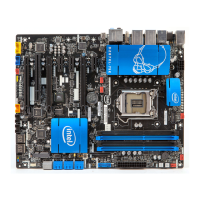Overview of BIOS Features
73
Table 35. Intel Visual BIOS Setup Display Areas (continued)
Performance Security Power Boot Exit
Displays and
Configures Memory,
Graphics, Bus, and
Processor overrides
Sets passwords
and security
features
Configures power
management features
and power supply
controls
Selects boot
options and
boot display
options
Saves or discards
changes to Setup
program options
Table 36 lists the function keys available for menu screens.
Table 36. BIOS Setup Program Function Keys
BIOS Setup Program
Function Key
Description
<←> or <→>
Selects a different menu screen (Moves the cursor left or right)
<↑> or <↓>
Selects an item (Moves the cursor up or down)
<Tab> Selects a field (Not implemented)
Mouse Allows control of all options and slider controls in Intel Visual BIOS
<Enter> Executes command or selects the submenu
<F9> Load the default configuration values for the current menu
<F10> Save the current values and exits the BIOS Setup program
<Esc> Exits the menu
3.2 BIOS Flash Memory Organization
The Serial Peripheral Interface Flash Memory (SPI Flash) includes a 96 Mb (12288 KB)
flash memory device.
3.3 Resource Configuration
3.3.1 PCI Express Autoconfiguration
The BIOS can automatically configure PCI Express devices. PCI Express devices may
be onboard or add-in cards. Autoconfiguration lets a user insert or remove PCI
Express cards without having to configure the system. When a user turns on the
system after adding a PCI Express card, the BIOS automatically configures interrupts,
the I/O space, and other system resources. Any interrupts set to Available in Setup
are considered to be available for use by the add-in card.
3.4 System Management BIOS (SMBIOS)
SMBIOS is a Desktop Management Interface (DMI) compliant method for managing
computers in a managed network.
The main component of SMBIOS is the Management Information Format (MIF)
database, which contains information about the computing system and its
components. Using SMBIOS, a system administrator can obtain the system types,

